2017-05-18 - Nº 107
Editorial
Esta é a Newsletter Nº 107 que se apresenta com o mesmo formato que as anteriores. Se gostar da Newsletter partilhe-a!
Todas as Newsletters encontram-se indexadas no link.
Esta Newsletter tem os seguintes tópicos:
Faz hoje anos que nascia em 1850 Oliver Heaviside. Este engenheiro electrotécnico inglês foi responsável pela adaptação dos números complexos ao estudo dos circuitos eléctricos. Foi responsável pela invenção de métodos matemáticos para a resolução de equações diferenciais, reformulou as equações de Maxwell em termos eléctricos, de forças magnéticas e fluxo de energia, para alem de ter formulado a analise vectorial. Foi ele que inventou e patenteou inúmeras invenções no campo das telecomunicações, como o cabo coaxial. Ficou conhecido por uma expressão que usou "Devo recusar o meu jantar porque não compreendo completamente o processo digestivo?". Faz também anos hoje que nascia em 1711 Roger Joseph Boscovich. Este croata de muitos talentos ficou conhecido para a história por ter produzido o percursor da teoria atómica e por ter feito muitas contribuições para a astronomia, incluindo o primeiro procedimento geométrico para determinar o equador de um planeta giratório a partir de três observações de uma característica de superfície e para calcular a órbita de um planeta a partir de três observações da sua posição. Em 1753, ele também descobriu que a Lua não tem atmosfera.
Esta semana a SpaceX lançou com sucesso um foguetão transportando um satélite de comunicações de grandes dimensões. O satélite da rede Inmarsat pesa cerca de 6 toneladas e estava acoplado ao foguetão Falcon 9. A HPE apresentou um computador que foi desenhado para a era da Big Data. Este passo é o ultimo "milestone" do projeto de pesquisa "A Maquina". O protótipo apresentado esta semana tem 160 terabytes de memória, capacidade idêntica a ter simultaneamente em memória todos os dados contidos em cerca de 160 milhões de livros. Esta semana no evento Google I/O foi apresentado pela Google a segunda geração de TPUs - Tensor Processing Units. Estas unidades de processamento permitem melhorar muito significativamente uma vasta gama de cargas de trabalho de Mchine Learning, incluindo o treino e a inferência. Tecnologias como o Google Translate, Search ou o Photos irão beneficiar destas tecnologias na melhoria dos resultados das mesmas. Ainda na conferência da Google, o seu CEO - Sundar Pichai - numa das apresentações deu uma clara indicação que a companhia está empenhada em colocar a Inteligência artificial a trabalhar para todos.
Na Newsletter desta semana apresentamos diversos projetos de maker assim como alguns modelos 3D que poderão ser úteis.
 João Alves ([email protected])
João Alves ([email protected])
O conteúdo da Newsletter encontra-se sob a licença  Creative Commons Attribution-NonCommercial-ShareAlike 4.0 International License.
Creative Commons Attribution-NonCommercial-ShareAlike 4.0 International License.
Novidades da Semana

SpaceX Launches Super-Heavy Communications Satellite
"A SpaceX Falcon 9 rocket lifted off from launch pad 39A at NASA's Kennedy Space Center here today (May 15) with a communications satellite that will complete Inmarsat's fifth-generation broadband network. The 23-story-tall booster soared off its seaside launch pad, which once hosted NASA's space shuttles and Apollo moon rockets, at 7:21 p.m. EDT (2321 GMT). It was the sixth of more than 20 missions SpaceX plans to fly this year. Perched on top of the two-stage rocket was the 13,400-lb. (6,100 kilograms) Inmarsat-5 F4 communications satellite, the heaviest spacecraft yet to be delivered by a Falcon booster into a geostationary transfer orbit some 22,300 miles (35,800 km) above Earth. The satellite separated from the Falcon 9's second stage right on time, about 32 minutes after liftoff. "It's been a great afternoon and evening," said SpaceX mission commentator John Insprucker. "All you can ask for today." Getting F4 into its intended orbit emptied the Falcon's fuel tanks, leaving no propellant for the booster's first stage to attempt a landing on either a drone barge or the ground." [...]
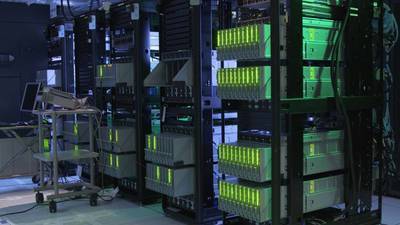
HPE Unveils Computer Built for the Era of Big Data
"Hewlett Packard Enterprise (NYSE: HPE) today introduced the world’s largest single-memory computer, the latest milestone in The Machine research project (The Machine). The Machine, which is the largest R&D program in the history of the company, is aimed at delivering a new paradigm called Memory-Driven Computing—an architecture custom-built for the big data era. “The secrets to the next great scientific breakthrough, industry-changing innovation or life-altering technology hide in plain sight behind the mountains of data we create every day,” said Meg Whitman, CEO of Hewlett Packard Enterprise. “To realize this promise, we can’t rely on the technologies of the past, we need a computer built for the big data era.” The prototype unveiled today contains 160 terabytes (TB) of memory, capable of simultaneously working with the data held in every book in the Library of Congress five times over—or approximately 160 million books. It has never been possible to hold and manipulate whole data sets of this size in a single-memory system, and this is just a glimpse of the immense potential of Memory-Driven Computing." [...]

Build and train machine learning models on our new Google Cloud TPUs
"We’re excited to announce that our second-generation Tensor Processing Units (TPUs) are coming to Google Cloud to accelerate a wide range of machine learning workloads, including both training and inference. We call them Cloud TPUs, and they will initially be available via Google Compute Engine. We’ve witnessed extraordinary advances in machine learning (ML) over the past few years. Neural networks have dramatically improved the quality of Google Translate, played a key role in ranking Google Search results and made it more convenient to find the photos you want with Google Photos. Machine learning allowed DeepMind’s AlphaGo program to defeat Lee Sedol, one of the world’s top Go players, and also made it possible for software to generate natural-looking sketches. These breakthroughs required enormous amounts of computation, both to train the underlying machine learning models and to run those models once they’re trained (this is called “inference”). We’ve designed, built and deployed a family of Tensor Processing Units, or TPUs, to allow us to support larger and larger amounts of machine learning computation, first internally and now externally. While our first TPU was designed to run machine learning models quickly and efficiently—to translate a set of sentences or choose the next move in Go—those models still had to be trained separately. Training a machine learning model is even more difficult than running it, and days or weeks of computation on the best available CPUs and GPUs are commonly required to reach state-of-the-art levels of accuracy. Research and engineering teams at Google and elsewhere have made great progress scaling machine learning training using readily-available hardware. However, this wasn’t enough to meet our machine learning needs, so we designed an entirely new machine learning system to eliminate bottlenecks and maximize overall performance. At the heart of this system is the second-generation TPU we're announcing today, which can both train and run machine learning models." [...]

Making AI work for everyone
"I’ve now been at Google for 13 years, and it’s remarkable how the company’s founding mission of making information universally accessible and useful is as relevant today as it was when I joined. From the start, we’ve looked to solve complex problems using deep computer science and insights, even as the technology around us forces dramatic change. The most complex problems tend to be ones that affect people’s daily lives, and it’s exciting to see how many people have made Google a part of their day—we’ve just passed 2 billion monthly active Android devices; YouTube has not only 1 billion users but also 1 billion hours of watchtime every day; people find their way along 1 billion kilometers across the planet using Google Maps each day. This growth would have been unthinkable without computing’s shift to mobile, which made us rethink all of our products—reinventing them to reflect new models of interaction like multi-touch screens. We are now witnessing a new shift in computing: the move from a mobile-first to an AI-first world. And as before, it is forcing us to reimagine our products for a world that allows a more natural, seamless way of interacting with technology. Think about Google Search: it was built on our ability to understand text in webpages. But now, thanks to advances in deep learning, we’re able to make images, photos and videos useful to people in a way they simply haven’t been before. Your camera can “see”; you can speak to your phone and get answers back—speech and vision are becoming as important to computing as the keyboard or multi-touch screens. " [...]
Outras Notícias
- Mars Rover Opportunity Begins Study of Valley's Origin
- Samsung Accelerates the Next Generation of IoT with New and Advanced SAMSUNG ARTIK™ Platform Products for Interoperability, Enhanced Security, and Connected Services
- AMD unveils Ryzen Threadripper: A monster CPU with 16 cores, 32 threads
- TI unveils the world's most precise single-chip millimeter wave sensor portfolio available today
Ciência e Tecnologia

Researchers unveil new password meter that will change how users make passwords
"One of the most popular passwords in 2016 was “qwertyuiop,” even though most password meters will tell you how weak that is. The problem is no existing meters offer any good advice to make it better—until now. Researchers from Carnegie Mellon University and the University of Chicago have just unveiled a new, state-of-the-art password meter that offers real-time feedback and advice to help people create better passwords. To evaluate its performance, the team conducted an online study in which they asked 4,509 people to use it to create a password. “Instead of just having a meter say, ‘Your password is bad,’ we thought it would be useful for the meter to say, ‘Here’s why it’s bad and here’s how you could do better,’” says CyLab Security and Privacy Institute faculty Nicolas Christin, a professor in the department of Engineering and Public Policy and the Institute for Software Research at Carnegie Mellon, and a co-author of the study. The study will be presented at this week’s CHI 2017 conference in Denver, Colorado, where it will also receive a “Best Paper Award.”" [...]

New robotic fish for environmental monitoring
"Researchers from UPM and University of Florence are developing a bio-inspired robot equipped with special chemical sensors able to detect the pH of water. A group of researchers from Centre for Automation and Robotics (CAR CSIC-UPM) in collaboration with researchers from University of Florence are designing autonomous underwater vehicle with biosensors to monitor water quality. These robots, that mimic a swimming fish in order to minimize the fish disturbance and stress, can detect in-situ real-time anomalies and this is suitable to control environmental conditions in fish farms. Aquaculture has become the fastest growing animal food sector in the world. Today, the production of fish, crustaceans and shellfish supplies around fifty percentages of all fish that is consumed by humans globally. In order to keep aquaculture systems at an optimal level and to avoid physiological stress and disease of fish, water quality and adequate nutrition must be monitored and controlled." [...]
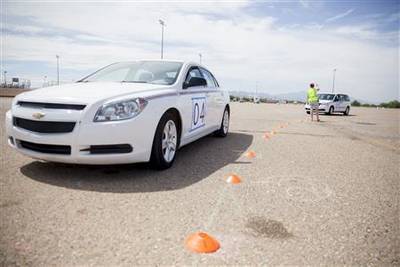
Experiments show that a few self-driving cars can dramatically improve traffic flow
"The presence of just a few autonomous vehicles can eliminate the stop-and-go driving of the human drivers in traffic, along with the accident risk and fuel inefficiency it causes, according to new research. The finding indicates that self-driving cars and related technology may be even closer to revolutionizing traffic control than previously thought. “Our experiments show that with as few as 5 percent of vehicles being automated and carefully controlled, we can eliminate stop-and-go waves caused by human driving behavior,” said Daniel B. Work, assistant professor at the University of Illinois at Urbana-Champaign, a lead researcher in the study. The use of autonomous vehicles to regulate traffic flow is the next innovation in the rapidly evolving science of traffic monitoring and control, Work said. Just as fixed traffic sensors have been replaced by crowd-sourced GPS data in many navigation systems, the use of self-driving cars is poised to replace classical freeway traffic control concepts like variable speed limits. Critical to the success of this innovation is a deeper understanding of the dynamic between these autonomous vehicles and the human drivers on the road." [...]

An Algorithm Summarizes Lengthy Text Surprisingly Well
"ho has time to read every article they see shared on Twitter or Facebook, or every document that’s relevant to their job? As information overload grows ever worse, computers may become our only hope for handling a growing deluge of documents. And it may become routine to rely on a machine to analyze and paraphrase articles, research papers, and other text for you. An algorithm developed by researchers at Salesforce shows how computers may eventually take on the job of summarizing documents. It uses several machine-learning tricks to produce surprisingly coherent and accurate snippets of text from longer pieces. And while it isn’t yet as good as a person, it hints at how condensing text could eventually become automated." [...]

Internet of things made simple: One sensor package does work of many
"Ubiquitous sensors seem almost synonymous with the internet of things (IoT), but some Carnegie Mellon University researchers say ubiquitous sensing — with a single, general purpose sensor for each room — may be better. The plug-in sensor package they have developed monitors multiple phenomena — sounds, vibration, light, heat, electromagnetic noise, temperature, etc. — in a room. With some help from machine-learning techniques, this suite of sensors can determine whether a faucet's left or right spigot is running, if the microwave door is open or how many paper towels have been dispensed. "The idea is you can plug this in and immediately turn a room into a smart environment," said Gierad Laput, a Ph.D. student in CMU's Human-Computer Interaction Institute (HCII). "You don't have to go out and buy expensive smart appliances, which probably can't talk to each other anyway, or attach sensors to everything you want to monitor, which can be hard to maintain as well as ugly. You just plug it into an outlet." It is an approach that Laput and his co-investigators in HCII's Future Interfaces Group call "Synthetic Sensors," because the raw feeds from the unit's nine sensors can be combined and interpreted in ways that can sense dozens of phenomena of interest. They presented their findings May 10 at CHI 2017, the Conference on Human Factors in Computing Systems, in Denver." [...]

FSU technology cracks, fixes passwords
"Inside the E-Crime Investigative Technologies Laboratory at Florida State University, researchers are focused on one mission — to develop the most sophisticated software possible to crack passwords. “We rely on passwords for many activities – online shopping, banking, and storing medical information,” said Sudhir Aggarwal, a professor in the FSU Department of Computer Science. “With credit card and social security numbers at risk, a stronger technology is needed to ensure we are creating passwords that will actually protect our information.” Aggarwal has long been focused on this issue of password cracking and other computer security issues during his tenure at Florida State. He has published extensively in academic journals on using probability to develop a context-free, grammar-based password cracking system." [...]

Stanford researchers develop crowdsourcing software to convene rapid, on-demand 'flash organizations'
"Crowdsourcing has become a popular way of making use of large groups of people to accomplish straightforward tasks – online reviews on Yelp, Wikipedia entries and Stanford University’s own Folding@Home, to name a few. A significant downside is that, because these projects usually rely on an inexpert workforce, they need to be built from basic and highly specific tasks that any person can carry out. Those limitations make traditional crowdsourcing impractical for the kinds of complex tasks many organizations need to accomplish – a challenge that researchers at Stanford tried to overcome with a new, more structured approach to crowdsourcing complex tasks, called flash organizations. “Traditional crowdsourcing can’t be applied to the most important goals that we, as humanity, want to pursue because these goals are open-ended and complex,” said Michael Bernstein, assistant professor of computer science at Stanford. “They simply cannot be predefined and cannot be broken down into thousands of independent parts. They require adaptation, re-planning and change that’s incompatible with traditional crowdsourcing.”" [...]

Better screenings through artificial intelligence
"Artificial intelligence—commonly known as AI—is already exceeding human abilities. Self-driving cars use AI to perform some tasks more safely than people. E-commerce companies use AI to tailor product ads to customers’ tastes more quickly and precisely than any breathing marketing analyst can. And soon AI will be used to “read” biomedical images more accurately than medical personnel alone—providing better early cervical cancer detection at lower cost than current methods. However, this does not necessarily mean radiologists will soon be out of business. “Humans and computers are very complementary,” says Xiaolei Huang, associate professor of computer science and engineering. “That’s what AI is all about.”" [...]
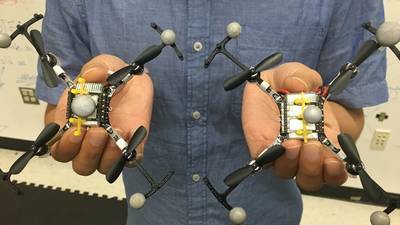
Virtual Top Hats Allow Swarming Robots to Fly in Tight Formation
"Georgia Institute of Technology researchers have created a team of free-flying robots that obeys the two rules of the air: don’t collide or undercut each other. They’ve also built autonomous blimps that recognize hand gestures and detect faces. Both projects will be presented at the 2017 IEEE International Conference on Robotics and Automation (ICRA) May 29 – June 3 in Singapore. In the first, five swarm quadcopters zip back and forth in formation, then change their behaviors based on user commands. The trick is to maneuver without smacking into each other or flying underneath another machine. If a robot cuts into the airstream of a higher flying quadcopter, the lower machine must quickly recover from the turbulent air or risk falling out of the sky. “Ground robots have had built-in safety ‘bubbles’ around them for a long time to avoid crashing,” said Magnus Egerstedt, the Georgia Tech School of Electrical and Computer Engineering professor who oversees the project. “Our quadcopters must also include a cylindrical ‘do not touch’ area to avoid messing up the airflow for each other. They’re basically wearing virtual top hats.” As long as the Georgia Tech machines avoid flying in the two-foot space below their neighbor, they can swarm freely without a problem. That typically means they dart around each other rather than going low." [...]

Gas gives laser-induced graphene super properties
"Rice University scientists who invented laser-induced graphene (LIG) for applications like supercapacitors have now figured out a way to make the spongy graphene either superhydrophobic or superhydrophilic. Until recently, the Rice lab of James Tour made LIG only in open air, using a laser to burn part of the way through a flexible polyimide sheet to get interconnected flakes of graphene. But putting the polymer in a closed environment with various gases changed the product’s properties. Forming LIG in argon or hydrogen makes it superhydrophobic, or water-avoiding, a property highly valued for separating water from oil or de-icing surfaces. Forming it in oxygen or air makes it superhydrophilic, or water-attracting, and that makes it highly soluble. The research at Rice and at Ben-Gurion University in Israel is the subject of a paper in Advanced Materials. “Labs could make graphene either hydrophobic or hydrophilic before, but it involved multiple steps of either wet-chemical or chemical vapor deposition processes,” Tour said. “We’re doing this in one step with relatively cheap materials in a homemade atmosphere chamber.” The labs got a bonus when they discovered that fabricating LIG in oxygen increased the number of defects – 5- and 7-atom rings – in the graphene flakes, improving its capacitance and its performance when used as an electrode material for microsupercapacitors. Changes in the chemical content of the gas and even changes in the direction of the laser raster pattern altered the material, leading the researchers to believe LIG’s hydrophobic or –philic properties could be tuned." [...]

New 3D printing method promises vastly superior medical implants for millions
"For the millions of people every year who have or need medical devices implanted, a new advancement in 3D printing technology developed at the University of Florida promises significantly quicker implantation of devices that are stronger, less expensive, more flexible and more comfortable than anything currently available. In a paper published today in the journal Science Advances, researchers lay out the process they developed for using 3D printing and soft silicone to manufacture items that millions of patients use: ports for draining bodily fluids, implantable bands, balloons, soft catheters, slings and meshes. Currently, such devices are molded, which could take days or weeks to create customized parts designed to fit an individual patient. The 3D printing method cuts that time to hours, potentially saving lives. What’s more, extremely small and complex devices, such as drainage tubes containing pressure-sensitive valves, simply cannot be molded in one step. With the UF team’s new method, however, they can be printed. “Our new material provides support for the liquid silicone as it is 3D printing, allowing us create very complex structures and even encapsulated parts out of silicone elastomer,” said lead author Christopher O’Bryan, a mechanical and aerospace engineering doctoral student in UF’s Herbert Wertheim College of Engineering and lead author on the paper." [...]
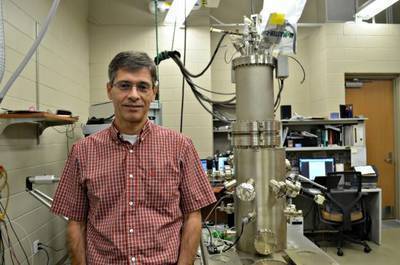
Physics May Speed Up Solutions for Tough Computational Problems
"A well-known computational problem seeks to find the most efficient route for a traveling salesman to visit clients in a number of cities. Seemingly simple, it’s actually surprisingly complex and much studied, with implications in fields as wide-ranging as manufacturing and air-traffic control. Researchers from the University of Central Florida and Boston University have developed a novel approach to solve such difficult computational problems more quickly. As reported last week in Nature Communications, they’ve discovered a way of applying statistical mechanics, a branch of physics, to create more efficient algorithms that can run on traditional computers or a new type of quantum computational machine, said Professor Eduardo Mucciolo, chair of the Department of Physics in UCF’s College of Sciences. Statistical mechanics was developed to study solids, gasses and liquids at macroscopic scales, but is now used to describe a variety of complex states of matter, from magnetism to superconductivity. Methods derived from statistical mechanics have also been applied to understand traffic patterns, the behavior of networks of neurons, sand avalanches and stock market fluctuations. There already are successful algorithms based on statistical mechanics that are used to solve computational problems. Such algorithms map problems onto a model of binary variables on the nodes of a graph, and the solution is encoded on the configuration of the model with the lowest energy. By building the model into hardware or a computer simulation, researchers can cool the system until it reaches its lowest energy, revealing the solution." [...]
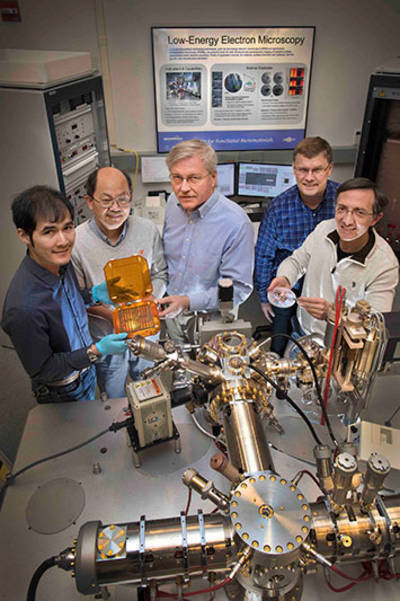
Scientists Demonstrate New Real-Time Technique for Studying Ionic Liquids at Electrode Interfaces
"Ionic liquids—salts made by combining positively charged molecules (cations) and negatively charged molecules (anions) that are liquid at relatively low temperatures, often below room temperature—are increasingly being investigated for uses in batteries, supercapacitors, and transistors. Their unique physical and chemical properties, including good ionic conductivity, low flammability and volatility, and high thermal stability, make them well suited for such applications. But thousands of ionic liquids exist and exactly how they interact with the electrified surfaces of electrodes remains poorly understood, making it difficult to choose the proper ionic liquid for a particular application. Now, scientists at the U.S. Department of Energy’s (DOE) Brookhaven National Laboratory have demonstrated a new method for observing in real time how the ions of such liquids move and reconfigure as different voltages are applied to the electrodes. The method is described in a paper published on May 12 in the online edition of Advanced Materials." [...]
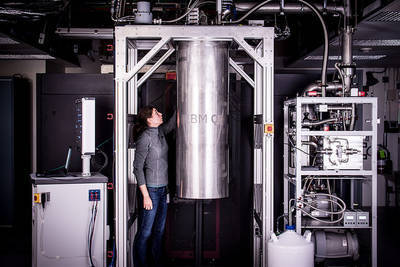
IBM Builds Its Most Powerful Universal Quantum Computing Processors
"IBM (NYSE: IBM) announced today it has successfully built and tested its most powerful universal quantum computing processors. The first upgraded processor will be available for use by developers, researchers, and programmers to explore quantum computing using a real quantum processor at no cost via the IBM Cloud. The second is a new prototype of a commercial processor, which will be the core for the first IBM Q early-access commercial systems. Launched in March 2017, IBM Q is an industry-first initiative to build commercially available universal quantum computing systems for business and science applications. IBM Q systems and services will be delivered via the IBM Cloud platform. IBM first opened public access to its quantum processors one year ago, to serve as an enablement tool for scientific research, a resource for university classrooms, and a catalyst of enthusiasm for the field. To date users have run more than 300,000 quantum experiments on the IBM Cloud. With the introduction of two new processors today for IBM Q, the company is building the foundation for solving practical problems in business and science that are intractable even with today’s most powerful classical computing systems. The two new IBM-developed processors include: A 16 qubit processor that will allow for more complex experimentation than the previously available 5 qubit processor. It is freely accessible for developers, programmers and researchers to run quantum algorithms, work with individual quantum bits, and explore tutorials and simulations. Beta access is available by request through the IBM Q experience and a new Software Development Kit is available on GitHub https://github.com/IBM/qiskit-sdk-py. IBM's first prototype commercial processor with 17 qubits and leverages significant materials, device, and architecture improvements to make it the most powerful quantum processor created to date by IBM. It has been engineered to be at least twice as powerful as what is available today to the public on the IBM Cloud and it will be the basis for the first IBM Q early-access commercial systems. "The significant engineering improvements announced today will allow IBM to scale future processors to include 50 or more qubits, and demonstrate computational capabilities beyond today’s classical computing systems,” said Arvind Krishna, senior vice president and director of IBM Research and Hybrid Cloud. “These powerful upgrades to our quantum systems, delivered via the IBM Cloud, allow us to imagine new applications and new frontiers for discovery that are virtually unattainable using classical computers alone.” The inherent computational power of a quantum processor to solve practical problems depends on far more than simply the number of qubits. Due to the fragile nature of quantum information, increasing the computational power requires advances in the quality of the qubits, how the qubits talk to each other and minimizing the quantum errors that can occur." [...]

Engaging Diamond for Next-Era Transistors
"As consumers around the world have become increasingly dependent on electronics, the transistor, a semiconductor component central to the operation of these devices, has become a critical subject of scientific research. Over the last several decades, scientists and engineers have been able to both shrink the average transistor size and dramatically reduce its production costs. The current generation of smartphones, for example, relies on chips that each feature over 3.3 billion transistors. Most transistors are silicon-based and silicon technology has driven the computer revolution. In some applications, however, silicon has significant limitations. These include use in high power electronic devices and in harsh environments like the engine of a car or under cosmic ray bombardment in space. Silicon devices are prone to faltering and failing in difficult environments. Addressing these challenges, Jiangwei Liu, from Japan’s National Institute for Materials Sciences, and his colleagues describe new work developing diamond-based transistors this week in the journal Applied Physics Letters, from AIP Publishing. “Silicon-based transistors often suffer from high switching loss during power transmission and fail when exposed to extremely high temperatures or levels of radiation,” Liu said. “Given the importance of developing devices that use less power and perform under harsh conditions, there has been a lot of interest within the broader scientific community in determining a way to build transistors that utilizes manufactured diamonds, which are a very durable material.” " [...]

3D-printed Soft Four Legged Robot Can Walk on Sand and Stone
"Engineers at the University of California San Diego have developed the first soft robot that is capable of walking on rough surfaces, such as sand and pebbles. The 3D-printed, four-legged robot can climb over obstacles and walk on different terrains. Researchers led by Michael Tolley, a mechanical engineering professor at the University of California San Diego, will present the robot at the IEEE International Conference on Robotics and Automation from May 29 to June 3 in Singapore. The robot could be used to capture sensor readings in dangerous environments or for search and rescue. The breakthrough was possible thanks to a high-end printer that allowed researchers to print soft and rigid materials together within the same components. This made it possible for researchers to design more complex shapes for the robot’s legs. Bringing together soft and rigid materials will help create a new generation of fast, agile robots that are more adaptable than their predecessors and can safely work side by side with humans, said Tolley. The idea of blending soft and hard materials into the robot’s body came from nature, he added. “In nature, complexity has a very low cost,” Tolley said. “Using new manufacturing techniques like 3D printing, we’re trying to translate this to robotics.”" [...]
Modelos 3D
Com a disponibilidade de ferramentas que permitem dar azo a nossa imaginação na criação de peças 3D e espaços como o thingiverse para as publicar, esta rubrica apresenta alguns modelos selecionados que poderão ser úteis.

simple door hinge 234 degree move
"small hinges for wide angle opening doors. Need nail or alike to engage the parts" [...]

Customizeable Length 30mm T-slot
"A 3030 T-slot with customizeable length. Open in the customizer app and change the length." [...]

Customizable Box with Sliding Top
"Adjust the cover tolerance so the top slides easily into the box, but is still held in place well enough. Lower tolerance = tighter fit." [...]
Projetos Maker
Diversos Projetos interessantes.

Micro Servo Based Robotic Arm With Record and Play Function
"here i have make a micro servo based robotic arm with Record & Play function there are four micro servos are used as shoulder, knee, palm & finger. The best and interesting part of this project is it have feature to record the motion and pay it again in infinite loop unless & until you press reset or pause button, after pressing reset the all old recorded moves get erased and robot is ready for new instructions. In this inscrutable i try to cove all necessary point it is possible that i skip something or you don't understand some thing so please watch the video given below for better understanding" [...]

Modern LED Desk Lamp...Powered by 5V USB
"This was an entirely new project for me. I've always been fascinated with edge-lit acrylic and I figured it would make for a nice desk lamp. The sanded edges of the acrylic pieces send off a diffused glow that works great for a desk or reading lamp. The LED strip inside is cheap and safe since there is no wiring involved. As with all power tool Instructables, please use proper PPE and follow all safety protocols for each machine. This Instructable is aimed to provide everything you need to make one for yourself. But if you have any questions, send them my way." [...]
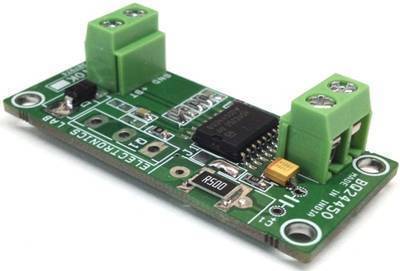
6V Lead Acid Battery Charger using BQ24450
"6V Lead acid (SLA) battery charger project is based on BQ24450 IC from Texas instruments. This charger project takes all the guesswork out of charging and maintaining your battery, no matter what season it is. Whether you have a Bike, Robot, RC Car, Truck, Boat, RV, Emergency Light, or any other vehicle with a 6v battery, simply hook this charger maintainer up to the battery. The bq24450 contains all the necessary circuitry to optimally control the charging of lead-acid batteries. The IC controls the charging current as well as the charging voltage to safely and efficiently charge the battery, maximizing battery capacity and life. The IC is configured as a simple constant-voltage float charge controller. The built-in precision voltage reference is especially temperature-compensated to track the characteristics of lead-acid cells, and maintains optimum charging voltage over an extended temperature range without using any external components. The low current consumption of the IC allows for accurate temperature monitoring by minimizing self-heating effects. In addition to the voltage- and current-regulating amplifiers, the IC features comparators that monitor the charging voltage and current. These comparators feed into an internal state machine that sequences the charge cycle." [...]
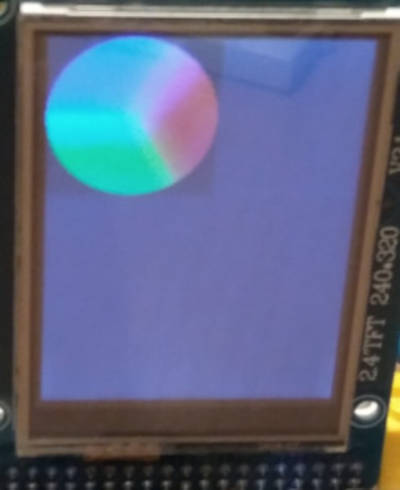
Raspberry PI, GFXLCD and image displaying
"During the work on GUI, I had to add a new function, ability to load and display an image. First, this post was a part of bigger one but I think it should be a post on its own. I tried to display numbers but we have no ability to display a text. So I thought about using images and that’s why we are here:)" [...]
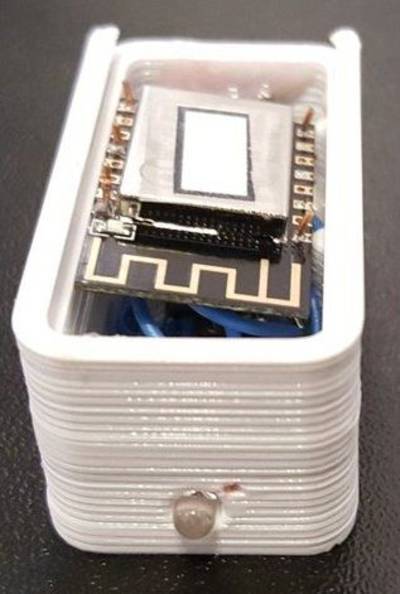
ESP-12 Infra Red Blaster
"Infra Red remote control blaster using esp8266. Transmits remote control codes received from Web supporting multiple output devices. Built in simple web page mainly for testing. Normal use is via POST messages which can come from web pages or from IFTTT / Alexa voice control. Supports an Amazon Echo/Dot activate detector to mute / quieten as soon as activate word is spoken. Commands are either single commands or sequences. Sequences can be stored as named macros which can then be used as commands or in other sequences. Recent history and list of macros may be obtained via the web interface. Supports OTA uploading of new firmware and uses WifiManager library for initial wifi set up." [...]

Arduino Easy Weather Station With BME280 Sensor
"In this tutorial we are going to take a first look at the new BME280 sensor, a new very interesting sensor. We are going to build a simple but very accurate weather station project. I have built a similar project 2 years ago, using different sensors. Now that we have a new sensor available which makes things easier, it’s time to update the project. As you can see, on the LCD display we can see the temperature, the humidity and the barometric pressure. The readings are updated every two seconds. This is a very easy project to build so it is ideal for beginners! Let’s build it!" [...]

ESP-8266 Live Instructable View Counter
"If you have ever created an Instructable, you will no doubt be familiar with the satisfaction of watching the amount of views on your instructable increase over time. What is even more satisfying, however, is to create a device that displays how many views you have on a 7 segment display, in real time. Making such a device is surprisingly simple as only a few components are required. In particular, an ESP-8266 board is used which connects to the internet and processes the data itself, meaning a web server or computer is not required to retrieve the data. Even better, the project can be built for around £20 or ($25). So, let's build!" [...]
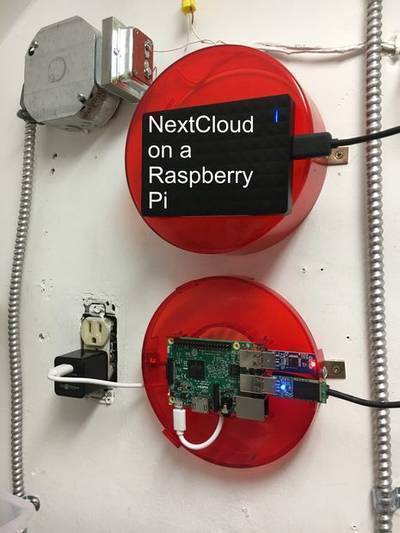
NextCloud on the Raspberry Pi - DIY Dropbox!
"So earlier I said that I would write an Instructable that would update my earlier one on an OwnCloud server for the Raspberry Pi, well that day has finally come! Today we have so much data. On my server, I have close to 100 GB's of photos and videos that I literally do not have the space to store anywhere else! In addition to that, I am a student (Crazy, I know) and the powerful workflow tools bundled with NextCloud are absolutely incredible." [...]

3D-Printed Robot Arm
"Hi! We are Kevin, Surya, and Tejas from Irvington High School. This is our 3D printed robot arm project that we made in our robotics class with Mrs. Berbawy. The original project blueprint for this arm was posted by Instructables user Beaconsfield. Our Instructables will follow her basic directions, as well as have our own experiences and fixes to the difficulties we encountered while completing this project." [...]

Adjustable constant current source
"When comes to electronic designing and testing, adjustable current sources facilitates to simulate "load" on circuit(s). The most common use of "constant current source" is to test performance of power supply units and battery packs. The current source introduced in this article is capable to handle current up to 6A with maximum input voltage of 50V. This is an operational amplifier based adjustable current source and it uses LM358 in a general voltage follower configuration. To handle large currents we use four 0.1Ω 20W resistors as "load resistor", and those load resistors are drive through pair of 55N06 N-channel MOSFET transistors. The power supply unit of this project is build around 9V x 2 (2A) step-down transformer and it is design to get regulated 12V DC voltage. In our design this 12V power source is used to drive LM358 Op-Amp and 12V cooling fan." [...]
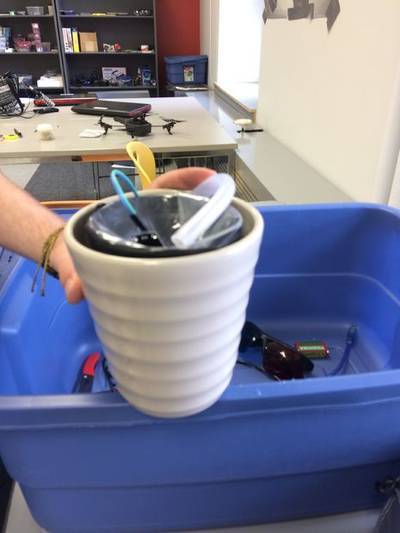
Arduino Self-Watering Plant Pot
"In today’s fast-paced era, everyone’s to-do lists are getting more and more daunting. Through this maze of assignments and appointments, many seemingly insignificant tasks can be forgotten and remain unchecked. For instance, watering your potted plants may seem unimportant when you have three papers to finish, four assignments to complete, two midterm exams to study for, a budget to handle and two upcoming birthday celebrations to prepare for. Unfortunately, your plants do need constant care, and, one morning, you’ll wake up to see them fragile and brittle, their leaves all dried out and their petals a much paler hue than you remembered. However, there is a way to avoid this upsetting situation without ruining your schedule and gnawing away at your precious time! We have devised a special pot that will measure the soil moisture of your potted plant and water it when said moisture becomes to low. This way, all you have to worry about is filling the water reservoir every now and then. Our object consist of a base, which is the water reservoir, in which we have inserted a submersible water pump. A tube is connected this pump and travels through a hole at the bottom of the first pot and comes out at the top to bend over the soil in the second pot. Indeed, there are two pots inserted one in another. The first one is the bigger one, and it contains the arduino and the battery. The arduino is linked to the pump and to a soil moisture sensor, which must be inserted in the soil in the second pot above. Whenever your soil becomes too dry, the motor of the pump is set into motion and water flows up the tube and into the second pot. To use this object, simply plant your flower or your herbs in the top pot and insert the soli moisture sensor in the soil. Make sure the tube is well-positionned over your soil, and make sure to check the base's water content every now and then." [...]
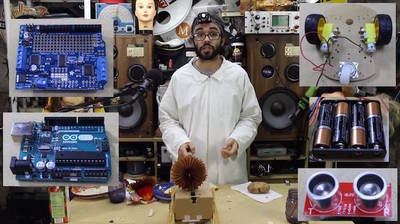
DIY Obstacle Avoiding Robot With Arduino and Ultrasonic Sensor
"This obstacle avoiding robot was inspired by the Roomba, but doesn’t work as well. In fact, the cleaning mechanism has been downgraded from a vacuum to a broom. For these reasons, it has been dubbed the “Zambroombi”, an obstacle avoiding Zamboni with broom bristles." [...]

Automatic Dispenser
"Is a dispenser with lights and sound activated by an application, this can be used for a multitude of situations such as a way to feed pets, or used in interactive centers to deliver food, or some other material that can enter the mechanism created ." [...]
WiDC - Wi-Fi Controlled FPV Robot (with Arduino, ESP8266 and DC Motors)
"What about using a remote controlled robot for exploring your surroundings, reaching inaccessible places, spying, take pictures, making films or broadcasting a video? This tutorial will show you how to make an inexpensible for all those purposes! This instructable is an improvement of my previous tutorial (https://www.instructables.com/id/Wi-fi-Controlled-FPV-Rover-Robot-with-Arduino-ESP8/), in which I present a faster home-made robot. It shows how to design a remotely controlled two-wheeled robot over a Wi-Fi network, using two DC motors, an Arduino Uno and an ESP8266 Wi-fi module. The robot can be controlled from an ordinary internet browser, using a HTML designed interface. An Android smartphone might de used to broadcast video and audio from the robot to the control interface. As in my previous tutorial, I show how to desing and build a low-cost frame for a robotic project, using just ordinary tools (no 3D printer, laser cutter or CNC router needed). One might notice that the components used here might not be optimised for its purpose. A NodeMCU might be used instead of the Arduino + ESP8266 combination, for instance. A Rapsberry Pi with a camera would replace the smartphone and controll the motors as well. It's even possible to use an Android smartphone as the "brain" for your robot. That's true..." [...]

Absolutes' Smart Home Automation
"Automation and IoT are leading the world's technology now. Innovation has brought smartness to play in the world.Smarter you are, more Better you can beat the innovation. Here Absolutes Proudly presents you the very first Product: Smart Home Automation. We have made use of Arduino and IR sensors to get automatic lights on and lights off to be done.We are looking to make the home smarter and also reduce the Electricity Consumption. We have Started up this in Chennai, India just because Population is large in India and therefore Electricity consumed is high. Amongst people's busy schedule we have also made this to make their life easier and also to make them concentrate on their work too. This is just the start, we will be having alot of advancements coming soon." [...]
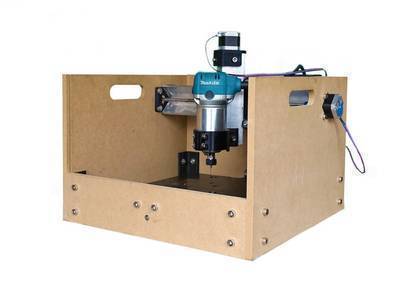
Sienci Mill One - Simple and Affordable Desktop CNC
"A desktop CNC machine is the perfect tool to make small to medium sized parts and projects from a nearly infinite number of materials. The Sienci Mill One is specifically designed to be simple, easy to use, require a minimal number of components, and provide the highest degree of performance and rigidity compared to other machines in its price range and class. A combination of simple hardware and software makes it perfect for both beginners and advanced makers, with over 70% of users being first time CNC operators. The Mill One was first launched on Kickstarter and was successfully funded in September 2016. Kickstarter units first started shipping at the end of January 2017, only five months after being successfully funded. Since then the Mill One has been shipped to over a hundred makers in 16 countries." [...]

Digital Battery Operated Powersupply
"Ever wanted a powersupply that you can use on the go, even without a wall outlet nearby? And wouldn't it be cool if it was also very precise, digital, and controllable via PC? In this instructable I will show you how to build exactly that: a digital battery operated powersupply, which is arduino compatible and can be controlled via the PC over USB. A while back I built a powersupply from an old ATX PSU, and while it works great, I wanted to step up my game with a digital powersupply. As already said, it is powered by batteries (2 lithium cells to be precise), and it can deliver a maximum of 20 V at 1 A; which is plenty for most of my projects that require a precise powersupply." [...]
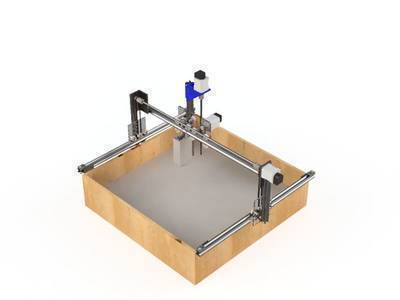
Agrobotec
"The objective of this project is to develop and automate a sowing system which can be adapted to any space or garden, as well as having the flexibility to be able to sow the amount of seeds that the user wants. It is able to offer at least 3 different crop varieties and its extension can be the size that the end user wishes." [...]

Simon Game
"his project is based on a handheld electronic game that was developed in the 1970s. The game consists of 4 coloured buttons. The buttons light up when they are pressed and a different tone is played for each button. In each round of the game, the microcontroller lights up a sequence of buttons. The player has to press the buttons in the same sequence. After each round, the length of the sequence is increased by 1." [...]
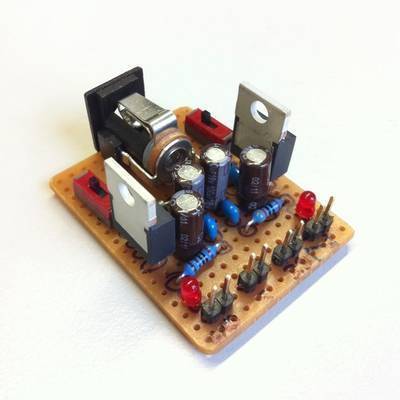
DIY Power Supply for 5V and 3.3V
"I'm currently migrating my old and hopefully interesting projects from my blog www.tiny-labs.com to instructables. I use this power supply regularly to power my embedded projects in the lab. It is very handy and tiny. I've used an USB port as power supply for my projects before. Some ICs need 3.3V instead of 5V as Vcc. Therefore I decided to build this small power supply. It uses a range of 7-14V (I use 7V for less power loss) as input voltage and supplies 5V and 3.3V with 1A each. Both supplies can be switched individually." [...]

Arduino ATtiny Fan or Any DC Motor PWM Speed Controller
"I've made fumes extractor from old Dell fan. It's quite powerful: 110mm 12V 0,6A, but unfortunately it's horribly noisy on full speed. I decided to make speed controller for it. I wanted it to be as simple as possible, mounted on fan, thus powered from it's voltage line (12V), potentiometer controlled. I chose ATtiny45 because main circuit would consist only of ATtiny and potentiometer. Alternative was 555 timer, but I wanted it simpler! My fan had wire for PWM control, but there's nothing stopping you from using it with any DC motor with additional transistor! I'll show how to program any ATtinyX5 or ATtinyX4 with Arduino IDE, how I've done my controller, how to use it with any DC motor, and how tu use zener diode as simplest voltage regulator." [...]
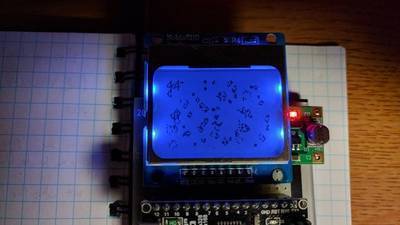
Game of Life With Nokia 5110 LCD
"College dorms generally don't allow you to have pets in the room. Even if you did keep a pet, you would have to dedicate time and money to feed it and maintain it's environment. However, sometimes it's still nice to have another lifeform in the room besides your roommate... Give digital life a try! Today I'm going to show how I made Conway's Game of Life on an Arduino Nano, displayed on the Nokia 5110 LCD Screen. The hardware setup should also allow you to explore other cellular automata algorithms and games of life. I like to look at Conway's game of life as a bunch of bacteria or microbes. By having a randomly generated starting map and following a simple set of rules, Conway's game of life can fascinate you with the different life forms, structures, and sequences it displays. It's like a digital petri-dish or fishtank that you can check on as a distraction." [...]
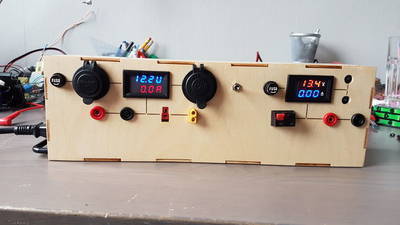
(adjustable)Power Supply 650watt 54amps for Under $50
"My idea: Adjustable power supply -Two cigarette lighter sockets: one for e.g tomtom, one with an usb chargers; Connectors: T-PLUG (RC), XT 60 (RC), Banana female sockets. Ammeter - Voltmeter; 10 amp (100volt); 100 amp (100volt)" [...]

DiscoJar: Sound Reactive Lamp With 288 RGB LEDs
"DiscoJar is a sound reactive DIY LED lamp, using an Ikea jar and 288 APA102 LEDs. It does real-time spectrum analysis of the audio input and shows a colorful view of it. This instructable will guide you how to build your own DiscoJar! It provides instructions and the full source code for the micro controller. A Teensy 3.2 micro controller is used to control the LEDs and to analyze and display the spectrum of incoming music using various visual effects. The lamp features a WiFi remote control and it can also be used as a mood lamp. It can e.g. show plasma effects or you can program your own custom patterns. Building the project costs around 100 Euros, the LEDs are the most expensive part. The project is easy to build, all you need are some soldering skills to solder the APA strips together." [...]
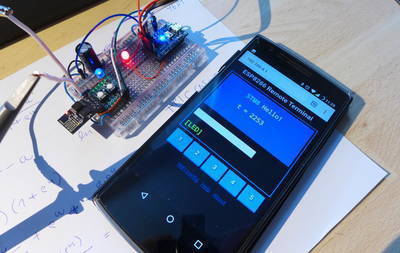
Wireless Terminal with ESP8266
"Here's a short write-up on a thing I've been working on recently. It lets you add a wireless interface to any of your breadboard projects, conveniently implemented as a terminal emulator accessible over WiFi. First, how this came about: It's a small university project, a device for students to add some "IoT oomph" to their seminar breadboard builds. It's aimed to be easy to use, hard to damage, and above all, fun to mess with for to the aspiring embedded hackers. I used ESP8266 in my Bachelor's project, so as the local "ESP expert," the task of implementing this fell on me. I wanted to build something like this for some time anyway and also needed to check out some of the cheap PCB fabs out there, so I welcomed the idea. As it turned out, fabbing boards at OSH Park is fun!" [...]

Pimp Your Mini Lighthouse
"Here is a mini lighthouse that comes from France (Brittany) which was illuminated by a candle, I removed the candle and inserted two electronic circuits a NE555 for the brightness of the LED and a 74HC04 for the LDR and the Battery. the battery is 4.8V NiMh in four AAA battery holder." [...]

Zen Garden CNC End Table
"I am a Makr. I sit at night in front of the TV with my family with a moleskin, or another one of my project notepads and sketch ideas. Many of my conversations are of the "wouldn't it be cool if _______" variety. Many of my ideas never leave my project pages. This one did. I think it is awesome. It is an enclosed zen garden built into an end table. The movement was inspired from a CNC or a 3D printer and actually started to use ramps 1.4 (a 3D printer Arduino shield) until I thought of a much easier way to build it. I wanted the end product to represent peacefulness. I wanted to bring some zen to my living room. I think that I did. Many of the things I build are not pretty, just the way it is. In the process of building this I never explained what exactly I was building to my wife. Just that it would be furniture that would be good-looking enough to want it in our house. To put this into context you should know that I share everything with my wife. She is my best friend. But on this project I simply promised her that the end result would be something that she would be proud to have in her living room. She knew it was an end table, but that was it. So I worked extra hard to make this end table look really nice for her. I have built 3D printers. I have also built some simple furniture (bookshelf, bench, etc.), but I have never built anything that combines technology into furniture. So I really thought this would be a fun project. I had the initial idea for this table about six months ago. The Tables and Desks contest (and all those beautiful black and yellow tools as prizes) inspired me to start this project." [...]

Huge POV Display
"Ever wanted to see your name in lights? In this instructable we will show you how! We will show you how to make a big Persistence Of Vision Display, or POV Display for short. It is basically a row of lights, LEDs in our case, which turns around very fast to show an image. Furthermore, we wanted to go big, so we made a display of 1 meter; ideal for displaying huge logo's! But what is this Persistence of vision thing? Wikipedia explains it as follows: Persistence of vision refers to the optical illusion that occurs when visual perception of an object does not cease for some time after the rays of light proceeding from it have ceased to enter the eye. The illusion has also been described as "retinal persistence" "persistence of impressions" or simply "persistence" and other variations. Or in normal terms: Our eyes are too slow to see the LEDs line by line, and will see it as a circle of continuous light. So by changing the colors at the right time, we can make images; how cool is that?! We made this display for a project at the university. We are in the first master year of electrical engineering at the VUB in Brussels, Belgium; that is also why its logo is the cover photo of this instructable! The project is a bit more advanced, and we will dive into all details and design considerations. But if you simply want to reproduce it, you can focus on the results only ;) We will start by building the rotating arm which holds the LED strip, and by making the enclosure that holds the arm. Next up are the electronics and the code. Let's get started!" [...]
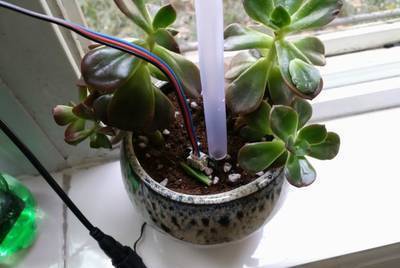
ESP8266 Tutorial: Build an Automatic Plant Watering System
"Recently, I saw many people creating smart-home equipment on the Internet, which aroused my interest, and then I created an automatic watering artifact which could surf the Internet. Programming of my device is based on DFRobot automatic watering kit. With ESP8266 module, the flower-watering kit could realize real time monitoring." [...]

Simple & Smart Robot Using Arduino
"Today I'm going to share information about a simple robot made using Arduino UNO , motorshild and some basic components. This project is easy to make and helps in learning about basic robotics and programming. The robot will be autonomous. In following Instructables I will be posting about modifications to make the robot obstacle avoidance and then controlled by IR. so this will be series of Tutorials, hope you like it and learn something from it." [...]
Face Tracking Pan-Tilt Camera
"A camera pan-and-tilt gimbal that is capable of tracking faces using computer vision and machine training so it can follow you around as you film or vlog. This way your face is always the centre of the action! You can also train this gimbal to follow not only human faces but also objects, pets, food, or anything you can imagine by using different training data." [...]
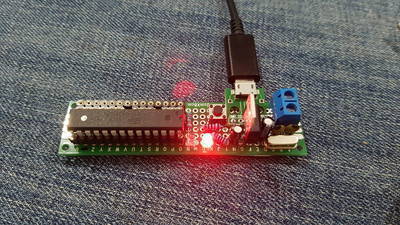
One More Small Footprint Barebone Arduino
"Instructables, and the internet, are so full of of barebone arduino projects that I hesitated to post this one. I mean I am not inventing something new here. I have received a good shipment of components from AliExpress yesterday and the first thing I made is one using a 2x8 cm pcb board and it actually came out quite neat. It was a soldering nightmare given the small size of the board and my insistence on having all the pins next to each other, something that I haven't seen (although I'm sure I haven't done anything new. someone somewhere must've done this before). The total cost came to US $3.7 and it took about one and a half hours to do given the amount of soldering work involved, and while it isn't the smallest creation out there, it's a pretty good sized one. So if you are interested to find out how did I manage to do this one, read on, and if you think to yourself "God not another one of those!" I won't blame you if you navigate away :)" [...]
120cm Neopixel LED Bar - 3x VU Meter + Other Light Effects - Arduino - Bluetooth
"A VU meter project was on my to-do list for a very long time. Finally found some time to make it happen. And while I was busy, why not just try to make a big one with some other effects included :)" [...]
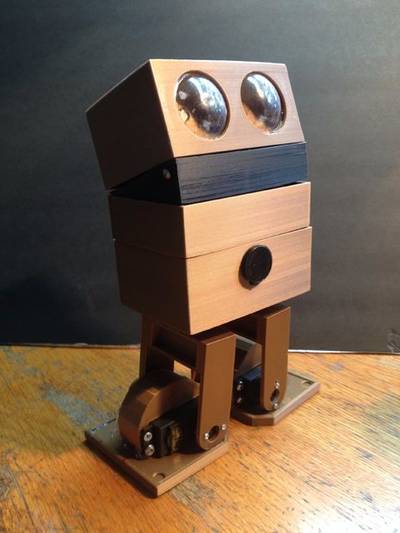
CHIP-E 2.0 a Dancing Robot
"I was really taken with the CHIP-E robot from RobotGeek (featured in MAKE magazine). Most of my robots have wires hanging out everywhere and don't have that sleek, futuristic look. I also thought that the square cubist look was really cute. The fact that he can do a sideways moonwalk was all I needed to jump into making my own dancing robot. Since RobotGeek has such a great set of instructions I thought that I could create my own and make a few changes. I redesigned his feet to match standard servos. I also designed legs in PLA instead of the metal legs included in RobotGeek's kit. I also wanted to have more expressive eyes and a unique controller. If you are new to robotics or just don't have a bin of servos and electronics, I suggest that you purchase the RobotGeek kit, which has all of the things you'll need." [...]
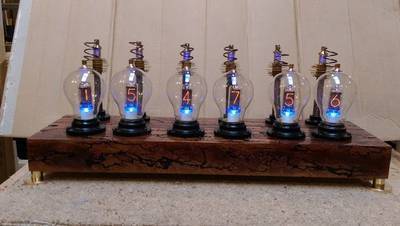
The Tesla Meets Edison Nixie Clock
"The idea of this clock came from thinking about what Nikola Tesla and Thomas Alva Edison could have produced were it not for their divergence in the field of electrical invention. Tesla was a former employee of Edison's and was considered a genius as he had the ability to formulate designs from a few sketches as he had an eidetic mind whereas Edison had a large team of assistants who were responsible for making his ideas work. Tesla despite all of his inventions ended up destitute while Edison made a fortune from his. Had it not been for these two gentlemen our world would be a very different place from what it is today. The clock itself runs on AC converted to DC so it would satisfy Edison who hated AC having had a bitter feud with another inventor, Westinghouse, the proponent of AC. The design reflects some of the important inventions of the time, Tesla for his coils and Edison for his lights. As my designs are off the wall and this is no different but I hope that it ties the two inventors together in my interpretation of a Tesla Meets Edison Nixie Tube Clock." [...]

RX/TX sequencer
"Much like the beacon keyer presented here earlier, this RX/TX sequencer is a simple but useful little device. Its typical use is in ham radio applications when a separate power amplifier (PA) and/or a sensitive low-noise pre-amplifier (LNA) is used. Care has then to be take to safely transition between RX and TX states – and that’s where this sequencer comes in." [...]

How to Build a FlameWheel Robot (A Remote Control Robot)
"Today we present the FlameWheel Robot assembly tutorial and quick-start guide! It is rather difficult to assemble this robot without guidance. Feel free to refer to my introductory tutorial today. Flamewheel (A 2WD Remote Control Robot) is part of our Education Robot Series. It is an agile two-wheeled robot with unique and innovative movement. Have fun assembling the robot yourself, while learning about electronics and mechanical principles." [...]

How to Make a 3D Printed Automatic Plant Watering System
"Automatic watering artifact is a modernly invented machine which could replace people to water flowers automatically, applicable to automatic flower care in family, company, hotel etc. 2 > Features of the automatic watering artifact: There are two watering modes of the automatic watering artifact: 1. automatically watering flowers according to soil moisture; 2. watering according to the set timing. In mode 1, users can set soil humidity threshold to realize automatic watering. If the actual soil humidity is less than the threshold, watering system will work automatically. In mode 2, users can set watering intervals to realize automatic watering. When time reaches the set value, watering system will work automatically. In addition, users could set water amount in the menu if thinking the default amount is too small. At the same time, we add a hook to the shell of the artifact, so that it can be easily hung to any flower pot." [...]
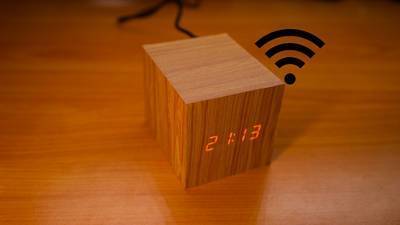
Wooden Digital Clock
"Wooden Digital Clock with Time, Temperature, Humidity, Alarm, WiFi controller through web browser, Advance display config, Stop alarm by vibration sensor, size : 64 x 64 x 79 mm . i use PLA with wood veneer instead of full wood. my room's too small for put woodworking tools" [...]

Rainbow Pastel Garden Lamp
"I've had Malibu Lights outside for years. Its nice having a big low voltage power supply to play with. Lately I've been "upgrading" the lights. Led bulbs seemed the obvious progression but then I had a pumpkin LED go too far... https://www.instructables.com/id/50W-RGB-LED-Infla... Even my umbrella got some Led's https://www.instructables.com/id/Ultimate-LED-Mark... So when my wife's Zen Garden Waterfall's pump died I couldn't throw it away. Something about its shape said "light me up", so I did." [...]
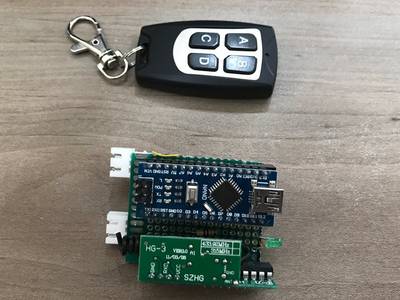
Arduino Bike Blink Lights
"This is my Light-Bag bike project with Arduino. Making the RGB leds blink to the left/right , while controlling them with RC attached to the front handle. Arduino nano with 2 RGB led strips, attached to bag pack and operated by 4 channel RF control. This project made for rear signaling when riding a bike." [...]
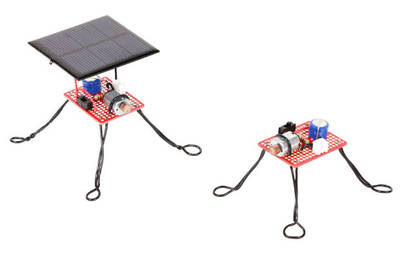
Supercapacitor Vibrobot
"For this project we are going to take advantage of supercapacitors to power a vibrobot. In other words, we are going to be using 15F capacitors to power vibrating motors to make robots which move around through vibrations. The basic model has an on/off switch and a charging port to allow it to be charged up between uses. The more advanced version also includes a small solar cell to let it be charged by the sun when not being used." [...]
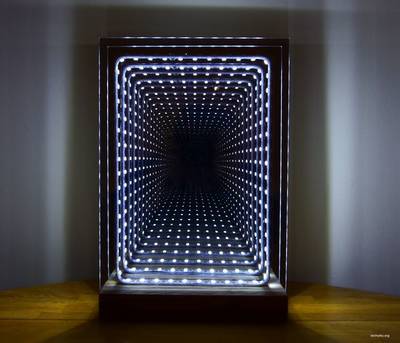
Modern Led Infinity Mirror Table Lamp
"In this instructable I am going to describe how to make a modern styled infinity mirror, which also works really well as a table lamp and looks fantastic. The infinity mirror is powered by a low voltage dc power supply and employs led lights." [...]
That's all Folks!


